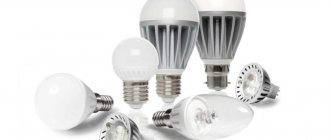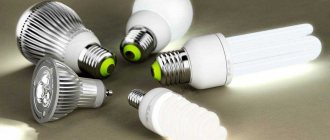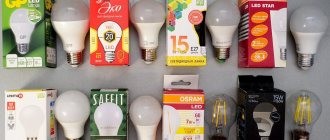Almost every manufacturer, one way or another, overestimates the service life of LED lamps. This is explained very simply - compared to conventional incandescent lamps, LED lamps are always much more expensive, so the buyer needs to be encouraged to spend money on this particular product. And then marketers calculated the two most serious factors that directly affect the buyer’s desire to purchase a new product - energy savings and a longer lamp life.
Marketers, of course, are smart guys, so it’s a good idea to figure out how things really are in order to protect yourself from unnecessary disappointments.
Service life: manufacturers' promises and realities
On the Internet you can find the average service life of any light-emitting diode (LED) lamp, regardless of the manufacturer – 50 thousand hours. That is, more than 2083 days or 5 years. But it is worth knowing that no real research has been conducted on this topic (at least in Russia), so it is not possible to confirm this tempting figure experimentally.
The service life of a typical incandescent lamp is about a thousand hours. Luminescent - from 6 to 10 thousand hours.
We also need to take into account our realities - with voltage drops, poor quality wiring and emergency shutdowns. And if we are talking about street lighting, then adverse weather conditions can also affect the service life of the lamps. In general, there are many factors, it is almost impossible to exclude them, so you should not hope for the declared service life of 5-7 years.
Typically, an LED lamp requires a standard voltage of 220 volts. But almost all of them will work at lower voltage. The maximum low and maximum voltage values for each lamp are indicated on the packaging.
Correspondence of electrical and optical parts to each other.
Separately, it is worth noting that the quality of the LED lamp is affected by the driver load factor. The driver load factor shows how much the driver is loaded from its design capacity. For example: the driver is rated at 150 W, and the LED module connected to it consumes 75 W, i.e. The driver operates underload and its load factor is 50%. If you connect an LED module that consumes 150 W to such a driver, then the driver will be fully loaded and will operate in optimal mode (with a load factor of 100%). In reality, it is almost impossible to ensure 100% loading, but it is necessary to strive for this in order to get the maximum from the driver used.
In Shine outdoor LED lamps, we implemented a Philips driver load factor of the maximum power of at least 85%, thereby ensuring high-quality input electrical characteristics for LED modules and not allowing the driver to work “idle”.
The consequences of driver underload, although not externally noticeable, can be disastrous. Due to underload, the power factor deteriorates (we wrote about what this is in the article What is power factor?). As a result, more energy “walks” through the network and damages the wiring. Sudden power outages may occur due to network overload. In the worst case, when devices with a low power factor are switched on in groups, a short circuit may occur.
Features of “burnout” of LED lamps
LED lamps have one unique property that cannot be ignored. Their service life is divided into effective and full.
An LED lamp does not burn out immediately like a regular light bulb - it simply loses brightness over time. At the same time, the luminous flux decreases.
The full service life of the lamp will be considered the entire time it operates until it completely fails. Effective - the period during which it dims by 30% of its original brightness.
A conscientious manufacturer should indicate both of these terms when labeling a product, but often gets by with indicating only the full service life, which, moreover, can be hypothetical, as mentioned above.
Therefore, do not rush to buy the lamp that, as the packaging promises, will work for 5-7 years. It is quite possible that it will work that long, but by the end of its “life” it will shine no brighter than a kerosene lamp. So it will be more profitable to find a product from a manufacturer who honestly indicates the period of effective operation of the lamp, after which the brightness will inexorably (albeit slowly) decrease.
The effective life of white LEDs is approximately 10 thousand hours, and red, blue, yellow and green - about 25 thousand hours. With an average use of home lighting of 6 hours per day, the human eye begins to notice a decrease in the brightness of the lamp after about 4 years of its use.
Another little secret when choosing an LED lamp is the warranty period. The smaller it is, the lower the quality of the product offered. You should not buy lamps whose manufacturer has indicated a warranty period of 1 year - this is done in order to avoid mass exchange of failed lamps. A two-year warranty is a sign of average quality, and from 3 to 5 years is a good product that will serve you for a long time.
Shelf life of such ceiling lamps
Manufacturers' warranty for LED lamps ranges from 1 to 5 years. If the lamp fails before the stated time, you can contact the store and request its replacement. To do this, the seller will need to present a receipt confirming the purchase of the LED.
Reference! Since the receipt may fade and it will be difficult to determine the date of purchase from it, it would not hurt to photograph or make a copy after purchase. It is advisable to save a copy or photo until the expiration date of the LED lamp.
At the same time, by virtue of Part 5 of Article 18 of the Law “On Protection of Consumer Rights”, the absence of a receipt is not a basis for refusing to satisfy the buyer’s request to replace the LED.
When choosing LED lamps, you can focus on the warranty period stated by the manufacturer:
- a one-year period indicates the low quality of the lamps;
- two-year indicates the average quality of the lighting device;
- A three to five year warranty is established by manufacturers who are confident in the quality of their products.
The miser pays three times!
From the very beginning of the use of LED lamps, they began to be counterfeited. And since the original product was very expensive, and the Chinese “analogues” were several times cheaper, the demand for them was quite serious.
Only a few years have passed, prices for LED lamps have dropped significantly, but our eastern neighbors still continue to “send” counterfeit LED lamps to Russia. And they continue to buy them. Why shouldn't you do this?
- The quality of light from such a lamp can be completely unpredictable, which negatively affects health.
- The assembly of Chinese lamps always leaves much to be desired, and the most “harmless” thing that can happen during its use is that the plugs (automatic machine on the meter) will be knocked out or the chandelier will deteriorate.
- There is no service life in the case of counterfeit lamps; they can fail at any time.
Causes of breakdowns
There are several reasons leading to failure of an LED device:
- A sharp surge in voltage in the electrical network.
- Turning the light bulb on and off too often.
- Incorrectly designed lamp, resulting in overheating of the bulb.
- Problems with electrical wiring. Most often we are talking about incorrect switching and incorrectly selected conductor cross-sections.
- Physical damage to the lamp. This happens not only when there is a deliberate impact on the light bulb, but also due to, for example, regularly repeated vibration of building structures.
Not just for home
LED lamps are used not only for lighting apartments. They can be found in offices and on city streets. They are also successfully used in cosmetology. Therefore, it is worth saying a few words about the service life of “specialized” LED lamps and luminaires.
Armstrong-type ceiling lamps, consisting of several blocks of LEDs, are often used to illuminate offices, warehouses, shopping centers and other public buildings. Taking into account the fact that in such rooms the lamps work for more than 6 hours a day, the service life of the lamps is about 3-4 years, then they begin to lose their brightness.
The service life of street lamps and floodlights depends on operating conditions. Most manufacturers promise from 6 to 20 thousand hours of operation, but in fact the lamps do not always work that long due to their high sensitivity to elevated temperatures.
Directional lighting
Many LED bulbs have LEDs that all shine in the same direction.
As a result, most of the light is directed upward from the light source. If you screw this type of bulb into a table lamp, you will find that only a small portion of the light reaches the surface of the table. Therefore, the most popular are LED lamps, which shine in different directions, spreading light around them. Such lamps provide a more familiar light, similar to that familiar to everyone from incandescent lamps. In such lamps, the light “spreads” around it. To achieve this effect, special reflectors are placed inside the lamp.
How to extend service life
In order for the lamp to work longer, it is necessary to ensure that the heat generated by it is constantly dissipated, preventing “thermal degradation” of the LED. The very design of such a lamp (if it is of high quality) already provides for this process, and the owners of the device are left with only basic rules of care, which any housewife can easily cope with.
- Lamps must be regularly wiped from dust and even vacuumed. At the same time, it is strictly not recommended to use any detergents that can damage the lamp and even cause it to fail.
- All manipulations must be carried out only with the lamp turned off!
- LED strips should not be glued directly to wallpaper or furniture; it is better to use an aluminum profile for this purpose, which will remove the “excess” heat.
- If LED lamps in a public or industrial area constantly overheat and deteriorate, then it would be a good idea to contact any company that installs such lamps. Our specialists will help provide your lamps with high-quality heat dissipation and reduce the cost of purchasing lamps.
Taking into account all of the above, we can conclude: the service life of an LED lamp will almost always be less than what advertising and some manufacturers promise us. On average, it is approximately 3 years, but it depends on many factors that we have already told you about. And simple rules for caring for LED lamps will help extend their service life and avoid losing money.
Mechanical damage
Poor solder joints can deteriorate over time, causing the circuit to break. If the soldered connection of the crystal with the heat-sinking substrate is destroyed or even the contact area is reduced, this leads to accelerated degradation of the crystal.
The reason for the destruction of the connection, as well as the rupture of thin conductors leading to the crystal, can be internal mechanical stresses in the plastic. They arise both as a result of violations of production technology and during operation of the LED at a temperature exceeding the maximum permissible value. Philips CitySoul luminaires (Fig. 4) use an active fan-based cooling system.
Rice. 4. CitySoul lamp from Royal Philips Electronics
To increase the reliability of LEDs, crystals have recently begun to be filled with elastic transparent silicone. Mechanical stresses in this material are evenly distributed, which virtually eliminates the possibility of destruction of the connection between the conductors and the crystal.
Clouding of the primary optics
The primary LED optics (i.e., the optical system directly integrated into the design) is made of plastic or silicone. The clouding of these materials may be due to exposure to ultraviolet radiation. In white LEDs, built on the basis of ultraviolet LEDs coated with a three-color phosphor, this problem actually exists. But such LEDs have not yet become widespread.
In white LEDs based on blue-emitting crystals, clouding of the primary optics can again be caused by severe overheating. It should be noted that many modern types of LEDs do not have primary optics at all (Fig. 5).
Rice. 5. LEDs without primary optics











